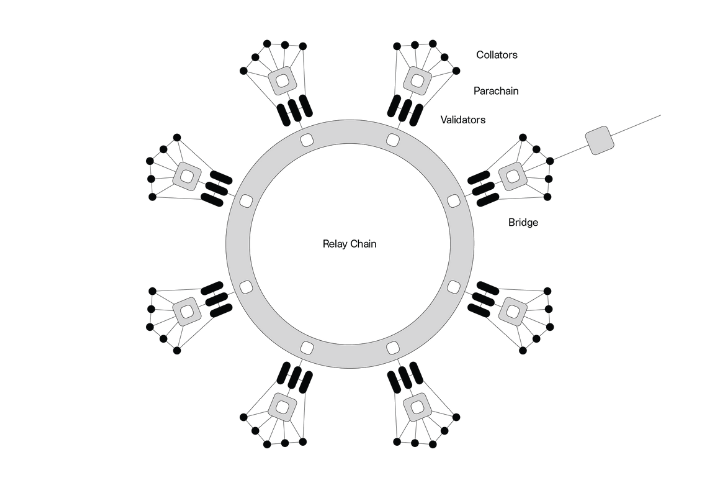Every day people interact with applications and technologies that are controlled by large or small organizations whose incentives will conflict with their personal benefits.
When people want to use and benefit from using such applications, they’re forced to tick their terms and conditions. Few people don’t even read and blindly hit the terms and conditions button. This way, the organization will have control over personal information i.e name, email id, address, mobile number, IP address, browsing history, etc. People also trust, their detailed information would be misused or stolen.
Similarly, the process performed in decentralized technologies such as blockchain has been denoted as they prioritize user’s sovereignty across the centralized control. As new systems are introduced, user’s aren’t required to trust third parties.
The truth is, blockchain technology is keeping the promise and struggling harder to build trust. The progress is going on till the date.
Thanks to Polkadot (DOT) – Decentralized blockchain interoperability platform.
Polkadot (DOT) is ready to deliver a powerful robust platform for Safety, Security and Scalability.
Page Contents
What is Polkadot (DOT)?
Polkadot (DOT) is the “next-generation blockchain protocol” that exhibits cross-chain transactions of any type, token, data or asset. Thereby, Polkadot (DOT) is making a massive amount of blockchain interoperable with one another.
Polkadot (DOT) will connect multiple blockchains into a single “unified network”. This blockchain protocol is specially designed for websites and applications. It offers complete control to users over the company’s terms and conditions or internet monopolies.
The feature “interoperability” seeks to build a completely decentralized and excellent private web. Finally, everything is controlled by the individual. Polkadot (DOT) is simplifying the process for new applications and services.
Everyone around the world is keeping their eyeballs on PolkaDot. Because this protocol connects networks, public chains, private chains, oracles and upcoming technologies. Here the independent blockchains can share personal data and transactions via the Polkadot (DOT) relay chain.
Who are the Founders of Polkadot (DOT)?
Polkadot was founded by three people.
- Dr Gavin Wood (Co-founder of Ethereum)
- Robert Habermeier and
- Peter Czaban
Polkadot was introduced by “Web3 Foundation” in 2016. The aim is to deliver open-source user-friendly decentralized web.
Gavin Wood is a famous person as he developed the coding language “Solidity”. The language used to develop decentralized applications on Ethereum. Wood took part in Ethereum creation. He also worked in Microsoft as a research scientist.
The co-founder Wood established “Party Technologies” in 2015. The ultimate goal is to develop user-friendly projects to build on “Ethereum”. Currently, Party Technologies is maintaining “Substrate”. It is the software development framework used by developers at Polkadot. With this framework, developers can create parachain in no time.
Robert Habermeier is a well-known researcher and developer of blockchain technology. Peter Czaban is the W3 foundation’s technology director. Czaban is developing the latest generation of “distributed technology”.
What makes Polkadot (DOT) Unique?
Many chains, one network
Polkadot is popularly called the “Sharded blockchain”. It means, Polkadot connects multiple chains within a single network. It allows blockchain to process information and transactions simultaneously with security guarantees.
Heterogenous sharding model
Million thanks to Polkadot (DOT)!!! Every blockchain in the network is optimized according to individual users rather than forcing the user to adapt to the “one-size-fits-all model”.
Blockchains that grow
A single blockchain may not be sufficient for decentralized applications in the future. The drawbacks in early blockchain are less throughput and lack of runtime. This is making blockchain impossible for scaling in multiple real-world use cases.
With the bridge, multiple blockchains together into a single network, all the transactions are performed parallelly. Ultimately, it eliminates the bottlenecks that have been encountered in previous cases while processing transactions.
As per analysis, Polkadot will also grow in the future by introducing nested relay chains. It will increase the shard counts that can be easily incorporated into the network.
Transparent Governance
Polkadot (DOT) is powered by the community. Considering blockchain, no third-party or governance procedure is involved. The individual has no power to propose any change.
Polkadot (DOT) works differently. This protocol can be governed by any individual who is owning DOTs. All the stakeholders can propose any change or modification to the existing proposal. Also, stakeholder’s can help while electing the council members.
Cross-chain composability
The blockchain design just looks like a closed garden. It means, one network cannot communicate with another network. Polkadot (DOT) tokens offer cross-chain composability. Also, message passing functionality allows individuals to communicate with each other and share information. With a bridge, Polkadot shards can also communicate with decentralized finance protocols and outside networks such as Ethereum.
How many Polkadot (DOT) tokens are there?
Let’s have a look at the number of Polkadot tokens that existed in circulation.
As per reports, there are currently 1 billion Polkadot tokens allocated in circulation from the maximum supply of 10 million in Aug 2020. These tokens have followed the rules of the network’s redenomination to avoid the usage of small decimals. The redenomination is used to make the calculation simpler.
Polkadot’s initial token purchase closed on October 27, 2017, growing a total of 485,331 ETH.
There is no maximum supply for Polkadot tokens. Polkadot is inflationary. The market rank of Polkadot (DOT) is 9. Currently, DOT token price is $19.32. The price value changes from time to time.
How does Polkadot (DOT) work?
Polkadot (DOT) allows transactions from multiple chains in the network at the same time. These can be optimized according to specific usage.
Polkadot has 3 core components

Relay chain – It’s considered the core layer of the network. At the Relay chain, bookkeepers will overlook all the network transactions.
The relay chain is the heart of Polkadot’s network. The chain helps to create constant, interoperability and security around the network of multiple chains.
Parachain – This is made of individual blockchains that are connected in a parallel manner.
Parachains = Parallel Blockchain
The individual chain will have its own tokens that can be optimized for individual use cases.
Bridges
The bridge allows parachain to communicate with the established or external chains such as Bitcoin, Litecoin, Ethereum and more. The technique “Break-in and Break-out” smart contracts allows other blockchains to communicate with each other on the Polkadot network.
Advantages of Polkadot (DOT)
Polkadot (DOT) design is offering amazing advantages over traditional and legacy networks. It includes
- Heterogeneous sharding
- Scalability
- Transparent governance
- Cross-chain composability
- Upgradeability
Conclusion
Polkadot (DOT) is the next-generation blockchain protocol. This software combines the complete network of blockchain. It allows them to process or operate together at scale. Since Polkadot enables different types of information to be sent or received between any type of blockchain. Finally, with Polkadot, a massive range of use cases have been unlocked across the world. Polkadot (DOT) has three main components, relay chain, parachain and bridges.

